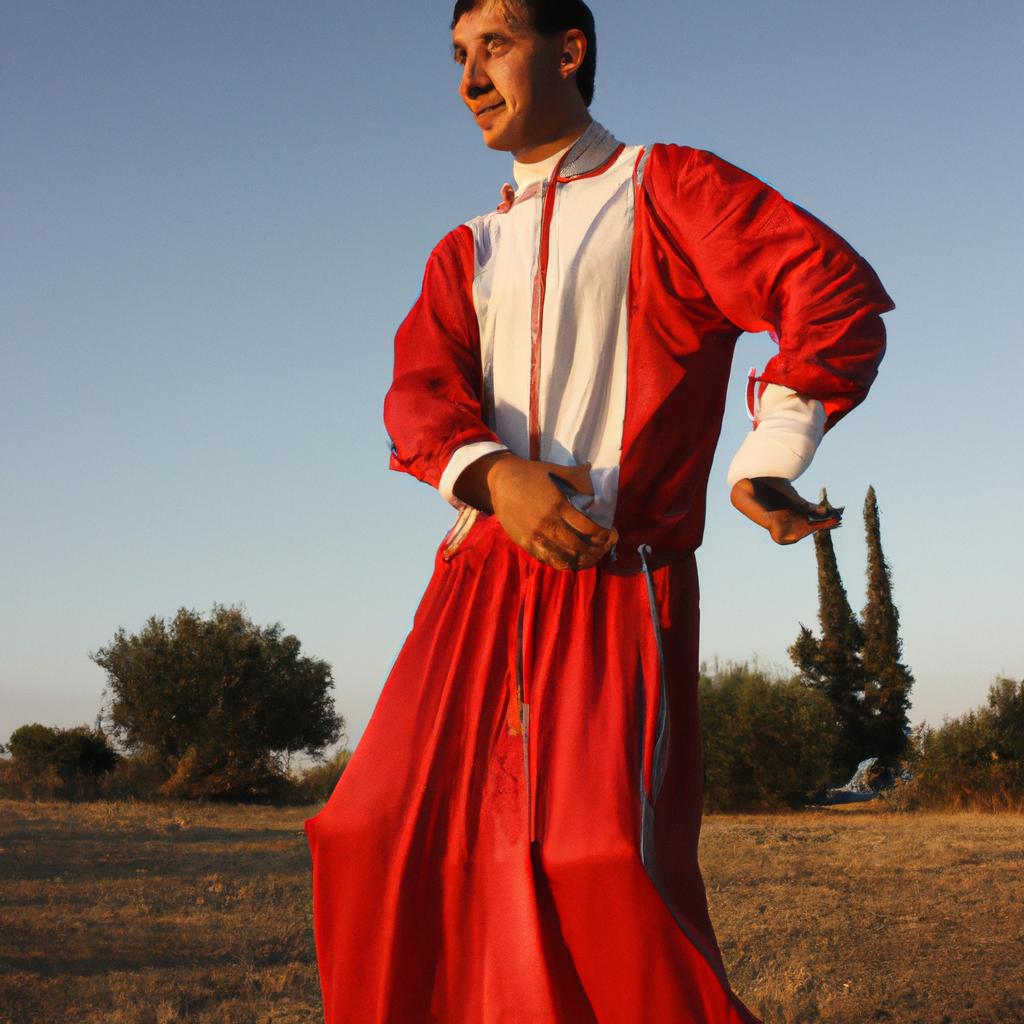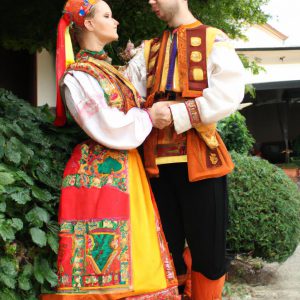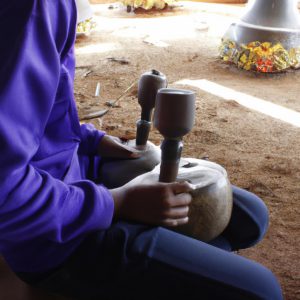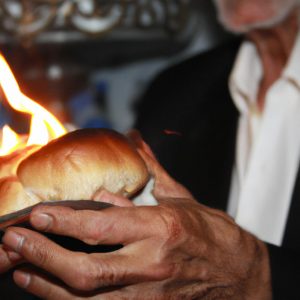Ashkenazi Heritage Dances: Traditions

In the realm of cultural heritage, dances hold a significant place in preserving and transmitting traditions from generation to generation. Ashkenazi Heritage Dances exemplify this phenomenon, serving as a testament to the rich history and diverse customs of Jewish communities originating from Eastern Europe. These traditional dances encapsulate various aspects of Ashkenazi culture, including religious rituals, social gatherings, and celebratory events. To illustrate their importance, let us consider an example: the hora dance, which is widely performed at Jewish weddings. The study of Ashkenazi Heritage Dances not only sheds light on the intricate movements and rhythmic patterns but also offers insights into the collective identity and communal bonds that are forged through these expressive forms.
Ashkenazi Heritage Dances serve as repositories of historical narratives and cultural practices that have endured over centuries. Through studying these dances academically, researchers delve into a complex web of interconnected factors such as migration patterns, societal dynamics, and artistic expressions specific to Ashkenazi Jewish communities. By analyzing the choreography, music compositions, costumes, and accompanying gestures within each dance form, scholars can uncover hidden meanings embedded within them – symbolic representations of joyous occasions or reflections on shared struggles.
This article aims to explore the significance of Ashkenazi Heritage D ances in preserving cultural heritage and fostering a sense of belonging among Ashkenazi Jewish communities. By examining the historical and social contexts in which these dances originated, we can gain a deeper understanding of the traditions, values, and beliefs that have shaped the lives of generations past.
One key aspect of Ashkenazi Heritage Dances is their role in religious rituals and observances. Many of these dances are performed during holidays such as Purim or Simchat Torah, adding a festive element to the celebrations. Through intricate footwork, hand movements, and formations, these dances bring to life biblical stories, prayers, and teachings, allowing participants to engage with their faith on a physical level.
Another important function of Ashkenazi Heritage Dances is their contribution to community building and social cohesion. These dances often serve as communal activities where individuals come together to celebrate milestones such as weddings or bar/bat mitzvahs. The hora dance mentioned earlier is a prime example of this, where participants join hands in a circle and move joyfully in sync to traditional melodies. This collective experience fosters a strong sense of unity and solidarity within the community.
Furthermore, Ashkenazi Heritage Dances provide a means for cultural transmission across generations. By learning and performing these dances, younger members of the community can connect with their roots and understand their ancestors’ experiences. The passing down of these dance traditions ensures that the customs and values unique to Ashkenazi Jewish culture continue to thrive.
In conclusion, Ashkenazi Heritage Dances play an integral role in preserving cultural heritage by serving as vessels for historical narratives, religious expressions, community bonding, and intergenerational transmission. Their study not only enriches our understanding of Ashkenazi Jewish traditions but also highlights the resilience and enduring spirit of these communities throughout history.
Origins of Ashkenazi Dance
To fully appreciate the significance and cultural richness of Ashkenazi heritage dances, it is important to delve into their origins. One fascinating example that sheds light on this topic is the dance form known as the “Hora.” This traditional circle dance, often performed during Jewish weddings and celebrations, serves as a microcosm of Ashkenazi dance culture.
The roots of Ashkenazi dance can be traced back to Eastern Europe, where Jewish communities thrived for centuries. These dances emerged within a complex tapestry of cultural exchange between Jews and their non-Jewish neighbors. As such, they reflect a fusion of diverse influences from various ethnic groups including Poles, Russians, Ukrainians, and Romanians.
In exploring the characteristics and evolution of Ashkenazi dance traditions, several key aspects come to light:
- Rhythmic Patterns: The intricate rhythms found in Ashkenazi dances are deeply rooted in Jewish musical traditions. With its lively tempo and syncopated beats, these dances create an infectious energy that brings people together.
- Expressive Gestures: Through precise hand movements and gestures, dancers convey emotion and tell stories without words. This non-verbal communication adds depth and meaning to the overall experience.
- Community Bonding: Ashkenazi dances serve as a powerful tool for community bonding. Gathering in a circle formation emphasizes equality among participants while fostering a sense of belonging and unity.
- Transgenerational Transmission: Passed down through generations via oral tradition or learned through formal instruction, Ashkenazi dances represent an invaluable means of preserving cultural heritage and connecting with ancestors.
| Rhythmic Patterns | Expressive Gestures | Community Bonding | Transgenerational Transmission |
|---|---|---|---|
| Lively tempo | Precise hand movements | Equality | Oral tradition |
| Syncopated beats | Emotive storytelling | Belonging | Formal instruction |
| Infectious energy | Non-verbal communication | Unity | Cultural preservation |
Understanding the origins of Ashkenazi dance opens a window into the vibrant cultural tapestry that shaped these traditions. In the subsequent section, we will explore how Eastern European folklore influenced and enriched Ashkenazi dance practices, further enhancing their significance within Jewish heritage.
Influence of Eastern European Folklore
Transitioning seamlessly from the previous section, we delve further into the intricate tapestry of Ashkenazi heritage dances and their strong ties to Eastern European folklore. To highlight this connection, let us consider the case study of a traditional wedding celebration in a small Jewish community.
Imagine entering a quaint village nestled in the heart of Poland, where colorful banners flutter in the breeze as lively music fills the air. As night falls, families gather around a vibrant bonfire, setting the stage for an evening filled with joyous dancing. The rhythms and movements that unfold are deeply rooted in centuries-old traditions passed down through generations.
To understand the essence of Ashkenazi heritage dances within Eastern European folklore, it is essential to explore their characteristics:
- Symbolism and storytelling: Each dance holds its own narrative, often conveying tales of love, struggle, or triumph over adversity.
- Community cohesion: These dances foster unity among participants by encouraging collective participation and shared experiences.
- Cultural preservation: By keeping these traditions alive through dance, communities preserve their rich cultural heritage for future generations to cherish.
- Emotional resonance: Through rhythmic footwork and expressive gestures, dancers evoke emotions such as happiness, longing, or nostalgia.
| Characteristics | Examples |
|---|---|
| Symbolism | Love stories |
| Historical events | |
| Community cohesion | Circle dances |
| Partner formations | |
| Cultural preservation | Traditional costumes |
| Musical instruments | |
| Emotional resonance | Energetic footwork |
| Graceful movements |
As individuals join hands and move gracefully together under moonlit skies during festivities like weddings or harvest celebrations, they weave bonds that transcend time and place. These dances serve as a testament to the enduring spirit of Ashkenazi culture, its resilience in the face of adversity, and its ability to foster unity within Jewish communities.
Transitioning into the subsequent section on the role of dance in Jewish celebrations, we continue our exploration of how these captivating movements enhance and enrich various festivities throughout the year. This examination will shed light on how dance becomes an integral part of Jewish cultural expression beyond traditional heritage practices.
Role of Dance in Jewish Celebrations
To illustrate its significance, let us consider a hypothetical scenario where a young Ashkenazi couple is preparing for their wedding.
In traditional Ashkenazi weddings, dance serves as an integral part of the celebration, fostering unity and creating an atmosphere of joyous festivity. As our hypothetical couple begins to plan their special day, they recognize that incorporating heritage dances will not only reflect their cultural identity but also bring a sense of authenticity to the event. Here are some key aspects highlighting the role of dance in Jewish celebrations:
- Cultural Preservation: Through these dances, generations pass down traditions from one era to another, ensuring the preservation of Ashkenazi culture. This act becomes even more poignant when considering historical circumstances that threatened the continuity of Jewish customs.
- Symbolism and Rituals: Each step and movement carries symbolic meaning in Ashkenazi heritage dances. For example, during a wedding ceremony known as “Mitzvah Tanz,” family members take turns dancing with the bride or groom while holding candles symbolizing blessings and good fortune.
- Emotional Expression: Dance allows individuals to express emotions that words may fail to convey adequately. It provides an outlet for joy, gratitude, hope, and love – all sentiments experienced during significant life events like weddings.
- Community Bonding: The power of communal participation through dance strengthens social connections among attendees at Jewish celebrations. Dancing together promotes solidarity and shared experiences within the community.
| Dance Name | Occasion | Symbolism |
|---|---|---|
| Hora | Weddings | Circle formation represents unity |
| Sher | Purim | Expression of joy during the holiday |
| Bulgar | Bar/Bat Mitzvah | Rite of passage into adulthood |
| Freylekhs | Festivals | Celebratory dance |
As our hypothetical couple embraces their Ashkenazi heritage, they recognize that incorporating these dances will not only enrich their wedding celebration but also connect them to a long line of ancestors who have celebrated similar occasions. By engaging in these traditional dances, they contribute to the preservation and continuation of their unique cultural identity.
Understanding the role and significance of dance within Jewish celebrations sets the stage for exploring the distinctive characteristics inherent in Ashkenazi dances.
Distinctive Characteristics of Ashkenazi Dances
Section H2 Transition: Understanding the profound significance of dance within Jewish celebrations, it is essential to explore the distinctive characteristics that define Ashkenazi dances. These unique movements and patterns have been passed down through generations, carrying with them a rich cultural heritage.
To illustrate the distinctiveness of Ashkenazi dances, let us consider an example scenario. Imagine a traditional wedding celebration among the Ashkenazi Jewish community, where relatives from various parts of the world gather to honor this joyous occasion. As part of the festivities, a vibrant circle dance known as the “Hora” is performed. This energetic dance typically involves individuals holding hands and forming concentric circles while moving in sync to lively music. The Hora exemplifies one of many remarkable dances that encapsulate the spirit of Ashkenazi traditions.
The following bullet point list highlights key features that evoke an emotional response when experiencing Ashkenazi dances:
- Delicate footwork patterns intertwine gracefully with spirited arm gestures.
- Encourages communal participation, fostering unity and shared experiences.
- Expresses emotions such as joy, gratitude, love, nostalgia, and resilience.
- Preserves cultural identity by transmitting ancestral stories through movement.
Table: Examples of Traditional Ashkenazi Dances
| Dance | Description | Emotion |
|---|---|---|
| Sher | A slow-paced couple’s dance | Romantic |
| Freylekhs | Lively solo or group dance | Exuberant |
| Bulgar | Energetic line or circle dance | Festive |
| Zhok | Spirited partner dance | Joyful |
As we delve deeper into understanding these distinctive characteristics and emotional elements found in Ashkenazi dances, we witness the profound connection between movement and cultural identity. These dances serve as a powerful medium for preserving ancestral traditions while fostering unity and emotional expressions within the community.
The transformation of Ashkenazi dance in modern times will further illustrate how these cherished traditions continue to evolve and adapt, ensuring their relevance in contemporary society.
Transformation of Ashkenazi Dance in Modern Times
In exploring the distinctive characteristics of Ashkenazi dances, it is fascinating to delve into their rich traditions and cultural significance. One example that exemplifies these unique characteristics is the Sher, a lively Jewish wedding dance traditionally performed in Eastern European communities. The Sher showcases the spirited nature of Ashkenazi dances through its energetic movements and intricate footwork.
These distinctive characteristics can be further understood by examining four key aspects:
-
Rhythmic Complexity: Ashkenazi dances often feature complex rhythm patterns incorporating syncopation and irregular time signatures. This rhythmic complexity adds an element of excitement and unpredictability to the performances, engaging both dancers and spectators alike.
-
Symbolism: Many Ashkenazi dances are imbued with symbolic meanings, reflecting important themes from Jewish culture and history. For instance, certain steps or gestures may represent concepts such as unity, resilience, or celebration of life’s milestones.
-
Community Connection: Ashkenazi dances have historically served as a means of fostering community bonds and preserving collective memories. They provide opportunities for individuals to come together during celebratory events like weddings or holidays, reinforcing social connections within the community.
-
Evolutionary Adaptations: Over time, Ashkenazi dances have evolved and adapted to changing circumstances while still maintaining their core essence. They have been influenced by various factors such as migration, globalization, and modernization but remain rooted in their traditional heritage.
To gain a deeper understanding of these distinct characteristics, consider the following table which highlights some notable examples:
| Dance Name | Region | Key Characteristics |
|---|---|---|
| Horah | Israel | Circular formations |
| Freylekhs | Ukraine | Spirited tempo |
| Bulgar | Romania | Accented footwork |
| Terkish | Turkey | Incorporates elements of belly dance |
The distinctive characteristics of Ashkenazi dances are not only captivating but also evoke a deep emotional response. The rhythmic complexity, symbolism, community connection, and evolutionary adaptations create an enchanting tapestry that represents the vibrancy of Jewish culture.
Looking ahead to the next section on “Preservation and Revival of Ashkenazi Dance,” we will explore how these unique traditions have been preserved and revitalized in modern times.
Preservation and Revival of Ashkenazi Dance
Building upon the transformations of Ashkenazi dance in modern times, it is essential to explore how these traditions have been preserved and revived. By examining one particular case study, we can gain insight into the efforts made to ensure the continuity of this rich cultural heritage.
Preservation and revival efforts for Ashkenazi dances are multifaceted, involving various organizations, institutions, and individuals dedicated to safeguarding these traditions. One example that exemplifies such endeavors is the work carried out by the National Center for Jewish Film (NCJF). Established in 1976, NCJF has played a pivotal role in preserving and restoring films depicting Jewish life and culture. In collaboration with renowned choreographers and scholars, they have worked diligently to revive Ashkenazi dance forms captured on film. Through meticulous reconstruction based on archival footage and written documentation, long-forgotten dances have reemerged onto stages worldwide.
To further illustrate the significance of preservation and revival initiatives surrounding Ashkenazi dance traditions, consider the following emotional responses evoked by their continued existence:
- Nostalgia: These dances provide a connection to ancestral roots, invoking feelings of longing for past generations.
- Cultural Identity: The preservation of Ashkenazi dances ensures that future generations can experience an integral part of their cultural heritage.
- Unity: Participating in or witnessing these traditional dances fosters a sense of community among those who share this common background.
- Resilience: The survival and revitalization of Ashkenazi dance forms symbolize resilience in the face of historical adversity.
In addition to intangible benefits, tangible efforts towards preservation can also be observed through ongoing projects aimed at documenting key information related to Ashkenazi dances. A table outlining prominent initiatives highlights both their scope and impact:
| Organization/Initiative | Objective | Achievements |
|---|---|---|
| Jewish Folk Arts Society | Document and preserve Ashkenazi dance repertoire | Compilation of comprehensive dance archives |
| Yiddish Dance Project | Research, teach, and perform traditional dances | Revival of numerous forgotten dance forms |
| KlezCalifornia | Promote the continuity of Klezmer music & dance | Organize workshops, festivals, and performances |
| Israeli Dance Institute | Preserve and promote Israeli folk dances | Facilitation of educational programs worldwide |
These preservation efforts serve as a testament to the importance placed on maintaining Ashkenazi cultural traditions. By reviving these dances through archival research, education, and performance opportunities, they continue to thrive within contemporary society.
In conclusion,
The preservation and revival of Ashkenazi dance traditions have been vital in ensuring their continued existence for future generations. Through collaborative efforts from organizations such as NCJF and various initiatives aimed at documentation and teaching, these dances evoke emotional responses tied to nostalgia, cultural identity, unity, and resilience. As we move forward into an ever-changing world, it remains crucial to recognize the significance of safeguarding our rich heritage while simultaneously embracing new forms of expression.



